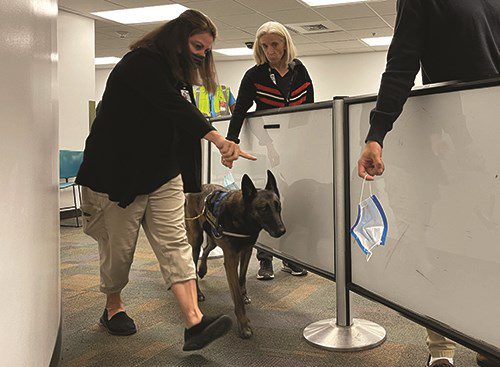When the novel coronavirus entered the scene in early 2020, hardly anyone could imagine the long-lasting effects it would have on everyday life. Nearly two years later, variants, masks, booster vaccines and testing are still the norm.
When the novel coronavirus entered the scene in early 2020, hardly anyone could imagine the long-lasting effects it would have on everyday life. Nearly two years later, variants, masks, booster vaccines and testing are still the norm.
For some employees at Miami International Airport (MIA), the changes have included a new screening procedure when they report for work each day. Specially trained dogs led by handlers sniffed their facemasks for chemical markers of COVID-19 during a 60-day pilot program that ended on Oct. 22, 2021. The study, conducted with American Airlines employees who volunteered to participate in the research, may prompt MIA officials to extend the screening program to other airport employees and possibly even passengers if trial results are promising enough. Interest is high, as the trial also has the potential to help legitimize this type of screening at airports throughout the industry. That said, canine COVID detection is not yet recognized by the U.S. Food and Drug Administration.
The two dogs used at MIA—a Belgian Malinois and a Dutch Shepherd—were trained to alert to the scent of volatile organic compounds (VOCs) excreted in the breath and sweat of people with COVID-19. The VOCs are common for all infected individuals, regardless of each person’s unique natural scents.
|
Facts and Figures Pilot Project: Deploying COVID-19 Detection Dogs Location: Miami Int’l Airport Airport Operator: Miami-Dade Aviation Dept. Scope: 60-day pilot at employee checkpoint to test suitability of detection dogs in airport setting Cost: $500/hour for 2 dogs & 2 handlers Funding: Miami-Dade Aviation Dept. Researcher/Dog Training Partner: Florida Int’l University Airline Partner: American Airlines Timeline: March 2021 – Miami Dade County Board directed county mayor to procure COVID detection dogs for deployment at MIA, Port of Miami & other select county facilities; trials at airport ran from Aug. 23-Oct. 22, 2021 Key Benefits: Added layer of COVID-19 protection for employees & passengers they serve; screening takes seconds & requires minimal human contact Accuracy Rate: 97.5% (average from previous double-blind trials) Next Step: Depending on pilot results, canine screening may be extended to busier employee checkpoints & possibly passenger checkpoints For More Information: go.fiu.edu/COVIDCanineStudy |
Workers in line at two of MIA’s seven employee checkpoints, simply held their masks down over a waist-high partition for the dogs to sniff. If the dogs detected the scent associated with COVID-19, they immediately sat down (alerted), and the associated employee was directed to get a rapid PCR test. Researchers report that the canines were able to quickly screen employees coming into each checkpoint with a proven accuracy rate of more than 97%.
During Phase 1 of the trial at Checkpoint 3, there was one alert to an employee, who later revealed that he or she had recently recovered from COVID-19 and just returned to work. The canines also alerted to one person who fled the checkpoint after COVID-19 was detected. It could not be determined if this person was an American Airlines employee, therefore a confirmation with PCR test could not be conducted. During Phase 2 of the trial at Checkpoint 1, there were two alerts to employees. At press time, the team was waiting for PCR test confirmation about those alerts.
In total, the pilot included 2,528 voluntary screenings of employees. The project team notes that the screening process resulted in no delays or inconveniences to the employees who participated while on their way to work.
“We are grateful to be on the cutting-edge of this particular project,” says Ken Pyatt, deputy director of the Miami-Dade Aviation Department. “In many ways, we are stepping out and doing the legwork for other airports by conducting this pilot program.”
The industry-leading project is a partnership between MIA and Florida International University, which performed the initial research and trained the dogs. The initiative began last March, when the Miami-Dade County Board of County Commissioners directed the County Mayor to procure dogs trained to detect COVID-19 for deployment at MIA, the Port of Miami and other county facilities with extensive public use or unique risks related to COVID-19.
County Commissioner Kionne L. McGhee announced the decision by citing a peer-reviewed paper published by the Global Forensic and Justice Center at Florida International University. The paper chronicled multiple double-blind studies about four dogs that demonstrated 97.5% accuracy detecting COVID-19. Highlighting the research, McGhee recommended Kenneth G. Furton, Ph.D., a professor of chemistry, provost and executive vice president of Florida International University, to lead the university team partnering with MIA.
Research Already in Progress
Furton has been researching, training and certifying detector dogs since 1998, most recently by using a patented chemical called universal detection calibrant. After dogs become proficient at detecting the pure synthetic compound, trainers can then change the odor they want the dogs to detect, for example drugs, explosives or COVID-19. Although COVID-19 is a new disease, Furton had been training dogs to detect other specific chemical compounds for more than two decades. His work has included studies regarding accelerants from suspected arson scenes, explosives, currency, drugs, human scent and even avocado crops in the early stages of infection from an invasive fungus.
“When County Commissioner Kionne McGhee initiated the partnership, I was excited,” says Furton, noting that he was particularly interested to determine how effective dogs could be detecting COVID-19.
Furton and his team had already trained a particular group of dogs to identify a specific fungus that affects laurel trees. Because of that training, it took the dogs just a few weeks of additional training to learn to detect COVID-19.
 “We trained four dogs with disposable face coverings provided by a local hospital,” explains Furton. The face coverings had been worn by confirmed COVID-19 patients and then sterilized with ultraviolet light. This killed the virus and made the masks safe for researchers to handle, but left the scent needed to train the dogs.
“We trained four dogs with disposable face coverings provided by a local hospital,” explains Furton. The face coverings had been worn by confirmed COVID-19 patients and then sterilized with ultraviolet light. This killed the virus and made the masks safe for researchers to handle, but left the scent needed to train the dogs.
After the dogs learned to detect COVID-19, researchers spent a few months collecting data and preparing an academic paper for peer review, which was published in June 2020 (see Facts & Figures on opposite page for website address). From there, the team developed protocols, training aids and deliverables for a six-month pilot program.
The Miami-Dade Aviation Department funded the pilot project, paying $500 per hour for two canine teams of COVID-19 detector dogs. Each team at MIA included one handler and one dog. Representatives from the Global Forensic and Justice Center Detection Dog program note that costs for other airports will vary according to variable factors, such as number of people screened, hours of operation, etc.
Officials at MIA and the research team knew it would be crucial to test the dogs’ accuracy in an airport environment, where they might become distracted from the noise and bustle of people.
“We decided it would be best to not start with passengers, but with employees who work at the airport,” Pyatt explains. “We felt they would be a lot more cooperative and willing since the program was voluntary.”
Airline Partnership
The employees who took part in the study were from American Airlines, one of MIA’s most prominent carriers. While participation was open to all of the carrier’s employees, the checkpoint selected was used heavily by ramp workers in particular. Furton explains that researchers chose a checkpoint that provided enough traffic to test the dogs without overwhelming them with distractions from the general public.
Two dogs and their handlers worked Mondays, Wednesdays and Fridays from 11 a.m. to 3 p.m., which are typically busy times at MIA.
 American Airlines posted a company representative at the checkpoint to explain that the program was voluntary, and that employees who chose to participate would receive free COVID-19 tests. “They really encouraged participation, and when there were volunteers, we were off to the races,” Pyatt recalls.
American Airlines posted a company representative at the checkpoint to explain that the program was voluntary, and that employees who chose to participate would receive free COVID-19 tests. “They really encouraged participation, and when there were volunteers, we were off to the races,” Pyatt recalls.
The first phase of the study launched on Aug. 23, 2021, and ran until Sept. 20.
When entering the checkpoint, volunteers took off their masks and hung them over a long hook that was draped over a sealed divider separating the employees from the dogs.
As the dogs walked by, smelling the masks, they sat down if they detected the specific chemical emitted by individuals with COVID-19. Such employees then took rapid PCR tests to confirm the dogs’ work. As the study progressed, the team determined that it was more efficient to have employees hold their masks instead of using hooks.
“The enormous advantage is that the dogs are very selective, meaning very few false positives,” Furton says. “It just takes a few seconds for the dogs to detect COVID.”
Phase 1 of the pilot involved a single isolated checkpoint to optimize the flow of individuals and mask presentation to the detector dogs. During Phase 2, the dogs and handlers again worked at an employee checkpoint, but their new location was a much busier environment. “It’s one thing to show their accuracy in a controlled setting, but when you put them in a setting with distractions, such as people trying to pet them, this can pose more challenges,” explains Furton.
As with the first phase, American Airlines personnel were the only participants.
“We don’t have a shortage of volunteers,” Pyatt reports. “We wanted to narrow it down to one company because there are protocols in place if the dog detects COVID. So, we wanted to make sure we didn’t pick a random employee who knows nothing about the process.”
He adds that the study will continue based on how well the dogs acclimate to busier locations, and how screening operations affect throughput.
“So far, it has been a good fit between us and Florida International University,” he says. “Also, American Airlines has been happy that their employees are volunteering to be tested. It’s a good marriage all the way around.”
With the innovative program still in its infancy, MIA, Florida International University and American are approaching the trial with open minds. They are optimistic about the positive affects the program could have, but also have questions regarding the logistics of expanding it further.

Potential Barriers
“There are several challenges for making this possible in an everyday airport setting,” Pyatt acknowledges. “Right now, the study is voluntary and only for AA employees. Therefore, there needs to be protocols in place to move toward testing others. Also, the dogs eventually need to be relieved, which will then require replacements.”
Additional challenges for MIA and other airports interested in similar canine screening programs include public perceptions regarding COVID-19. For instance, some individuals may not feel comfortable taking off their masks. This would need to be addressed if and when protocols are established for screening passengers. Airports would also need to make it clear that detection dogs provide an additional layer of screening, but would not eliminate testing.
As with any new program, efficiency and cost will be key factors.
“Once you have a system worked out, then the dogs are very cost-effective, because you can screen a very large number of people in a very short amount of time,” says Furton. “Even with a rapid PCR or other tests, it takes five minutes; and that might be a significant enough delay that would make it disruptive. But if a dog can just walk by within a matter of seconds to screen and doesn’t change the flow of people getting into a checkpoint, then it could be very efficient.”
With potential benefits and challenges in mind, MIA officials are reviewing the pilot and considering whether COVID-19 detection dogs will be used to screen other airport workers, visitors and passengers.
The Future is Telling
“We are going to have a meeting with Florida International University to determine what we want to do and if we want to continue; and then we will go from there,” says Pyatt. “But we’ve learned a lot about how we would administer a testing program if we had to do it with passengers.”
Even during the historic pandemic, 18.7 million passengers traveled through MIA in 2020. COVID-19 detection dogs have the potential to add a new layer of screening within seconds.
The ultimate goal would be to implement COVID-19 detection dogs at all 10 MIA passenger checkpoints. The performance of the two current dogs and handlers at the single checkpoint will determine how many dogs and handlers would be needed. Securing FDA approval for the dogs is another crucial step, and something airport officials expect Florida International University would handle.
“This then could be a viable test used to certify that people are free of COVID,” Pyatt remarks. “However, we are not there yet. We are still in the beginning stages.”
He likens the current testing and certification efforts to the steps airports took before unleashing dogs to work with TSA, Customs and Border Protection, and cargo personnel.
“This is nothing new to aviation,” notes Pyatt. “This is just a unique twist on the practices we’ve had in place for years.”
Before airports deployed other detection dogs, similar studies were performed to monitor their activity and performance. Researchers had to demonstrate proof of concept in busy airport environments and then perform double-blind studies that measured accuracy before dogs became a part of daily airport operations.
Currently, the pilot project at MIA is testing proof of concept. Its next phase may provide a roadmap for further implementation.
“As this evolves, COVID dogs may be no different from any other working dog in an airport,” Pyatt predicts. “Now, how long this will take is anybody’s guess.
“I feel very proud that this airport has forged the way and started the initial movement of how COVID-19 detection dogs could be deployed in an active airport environment. In some small way, wherever this ends up in years to come, we can say we were the starting point; and I think that means a lot.”
While MIA is blazing the trail here in North America, airports overseas are also experimenting with COVID detection dogs. Last year, Dubai International and Helsinki Airport deployed canines to help screen incoming passengers. In Helsinki, passengers participating in the voluntary program swiped their skin with special wipes, and then placed the wipes in cups for dogs to sniff.



